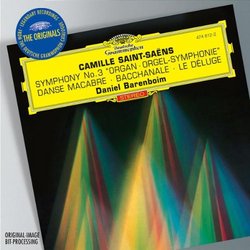| All Artists: Camille Saint-Saens, Daniel Barenboim, Chicago Symphony Orchestra, Gaston Litaize Title: Saint-Saëns: Symphony No. 3 "Organ"; Danse Macabre; Bacchanale; Le Déluge Members Wishing: 0 Total Copies: 0 Label: Dg Imports Original Release Date: 1/1/2004 Re-Release Date: 2/18/2004 Album Type: Import Genre: Classical Styles: Opera & Classical Vocal, Forms & Genres, Theatrical, Incidental & Program Music, Symphonies Number of Discs: 1 SwapaCD Credits: 1 UPC: 028947461227 |
Search - Camille Saint-Saens, Daniel Barenboim, Chicago Symphony Orchestra :: Saint-Saëns: Symphony No. 3 "Organ"; Danse Macabre; Bacchanale; Le Déluge
 | Camille Saint-Saens, Daniel Barenboim, Chicago Symphony Orchestra Saint-Saëns: Symphony No. 3 "Organ"; Danse Macabre; Bacchanale; Le Déluge Genre: Classical
|
Larger Image |
CD Details |
CD ReviewsTERRIFY ME A BIT MORE DAVID BRYSON | Glossop Derbyshire England | 12/17/2005 (4 out of 5 stars) "When the Philharmonic Society in London flattered Saint-Saens with the title of `The French Beethoven' and invited him to write a symphony, he warned them that it would be a terrifying one. He was drawn to discreet well-mannered orgies in his choice of musical themes, and it seems that the idea of the big organ part in the symphony originated in his collaboration with none other than the pious Bruckner when inaugurating the organ in the recently-completed Albert Hall. The work is in two main sections, each subdividing into two more, the four making up something very like the standard 4 movements of the classical symphony. The organ reserves its heavy artillery for the second part, and there is also a striking obbligato role for piano, usually thought to require two players. The organ in this recording is that in Chartres cathedral, no less, the organist is Gaston Litaize, and that recording, now digitally remastered, was done in 1976, those of the companion pieces dating from 1981 if I have understood the leaflet correctly.
This performance of the symphony strikes me as really rather good. It reflects credit on everyone concerned including the recording engineers, although I certainly feel that the pianist or pianists deserved a mention among the credits. Considering this work on its own for the moment, I might well have given 5 stars, although I happen to own another account which is just that little bit better. This account is on LP, but it is more recent (1986) than the performance under review, and the recording was in digital sound from the outset, the engineer being the redoubtable Mr Bear. The last time I searched for it I failed to find it in the current catalogues, but it is or was on Classics for Pleasure. The performers are the Royal Liverpool Philharmonic under a very young-looking conductor Andrew Litton whose other work I don't seem to have encountered, and the organist is Professor Ian Tracey at the mighty organ of Liverpool's Anglican cathedral, the largest cathedral organ in the world or so I'm told. There's not a lot in it, but I think I find just a touch more freshness in both the reading and the recording on the Liverpool version. What I quite certainly find is an awesome tone from the organ itself that even the Chartres instrument doesn't equal. Well done of course Professor Tracey, but Mr Bear has surpassed himself here. In addition there is the famous Bacchanale from Samson and Dalila, very fine and bacchanalian I thought, and by way of lowering the general level of frenzy there is the prelude to the oratorio Le Deluge. Last on the disc is the Danse Macabre, and it is really this that has stopped me from giving a fifth star. If anything in 19th century music, surely, needs a sense of diablerie about it, it's this, and I have to say I found it rather staid here. This is not a matter of the tempo - the composer specifically says that the tempo should be moderate - but of the sheer `feel' of the thing. This performance strikes me as being a little too earnest to be macabre. The production is in general very good, and the German liner-note by Dr Michael Stegemann, translated into French and Italian, is very thoughtful and helpful, focusing on the general question of the symphony and of instrumental music generally in 19th century France. If your command of any of these languages is up to it, I recommend that you ignore the English offering, which is a truly wretched little effort. In a note accompanying the music of Saint-Saens, which I like, I wish to read about Saint-Saens and not about Liszt, whose creative work seems to me a hopeless struggle against lack of the necessary natural endowment. The influences that the writer finds from not only Liszt but also Berlioz, Mendelssohn and even Haydn are of dubious validity and total inconsequence, and goodness knows what a newcomer to Saint-Saens will make of such stuff. I can recommend this record in good conscience, I think. The organ symphony is not particularly well known, it deserves to be, and it gets the best performance here - the smaller works, or at least two of them, are everywhere to hand in recordings that are easy to find. If that Liverpool production is ever reissued, it's the one I would recommend in preference, but for the time being this one will do perfectly well." |

 Track Listings (4) - Disc #1
Track Listings (4) - Disc #1